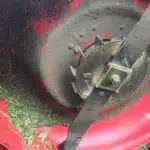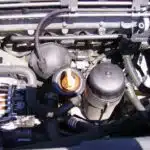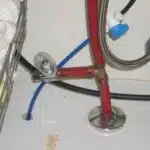As a small engine repair technician, I have seen many lawn mowers that are not performing at their best due to lack of maintenance. A well-maintained lawn mower not only gives you a well-manicured lawn but also extends the lifespan of your equipment. With regular tune-ups, you can keep your lawn mower running smoothly and prevent costly repairs.
In this article, I will guide you through three easy steps to tune up your lawn mower. These steps are simple and straightforward and can be performed by anyone with basic knowledge of small engines. By following these steps, you can ensure that your lawn mower is running efficiently and effectively, saving you time and money in the long run. So let’s get started on how to tune up your lawn mower in three easy steps!
Why Regular Maintenance Is Important For Your Lawn Mower
A lawn mower is an essential tool that helps keep your yard looking its best. However, like any other machine, it requires regular maintenance to ensure optimal performance and longevity. The importance of regular maintenance for your lawn mower cannot be overstated. Maintaining your lawn mower can prevent expensive repairs, extend its lifespan, and ensure that it operates at peak efficiency.
Neglecting regular maintenance can lead to a decrease in the performance of your lawn mower and even cause irreparable damage. As a small engine repair technician, I have seen many cases where lack of maintenance has resulted in costly repairs or even replacing the entire machine. In contrast, proper upkeep can help avoid these issues and provide long term benefits such as better fuel efficiency, increased power output, and reduced emissions.
Performing a lawn mower tune-up in just three simple steps can help you maintain your equipment with ease. Changing the oil and oil filter is one of the most critical steps in this process. Fresh oil ensures that internal components are lubricated correctly and running efficiently. A clean oil filter prevents contaminants from entering and damaging the engine. Replacing both regularly will contribute significantly to the longevity of your lawn mower’s life, ensuring that it functions optimally for years to come.
Step 1: Changing The Oil And Oil Filter
- Prior to changing the oil and oil filter, it is important to first check the oil level.
- The oil filter should be replaced if it is damaged or clogged.
- The engine should be turned off and allowed to cool before replacing the oil filter.
- The oil filter should be securely tightened to ensure a proper seal.
- The oil should be carefully added to the engine, making sure not to overfill it.
- The new oil should be of the correct grade and viscosity for the engine.
Checking The Oil Level
Checking the Oil Level is an essential part of maintaining a lawn mower. It is important to ensure that the oil level is adequate before starting the engine, as running the engine with low oil levels can cause significant damage. Therefore, it is crucial to check the oil level regularly and accurately.
To check the oil level accurately, follow these steps: Firstly, ensure that your lawn mower is cool and on a flat surface. Secondly, remove the dipstick from the oil fill tube and wipe it clean with a rag or towel. Thirdly, reinsert the dipstick into the tube completely and then remove it again to check the oil level.
Accuracy in checking your lawnmower’s oil levels cannot be overemphasized because failure to accurately gauge your lawn mower’s oil level can result in engine damage. A technician should also check for signs of contamination such as dirt or debris as this could affect how much lubricant is available for smooth operation of all parts requiring lubrication. Additionally, if there aren’t enough oils in your equipment, you’ll hear loud clattering sounds from various engine parts rubbing together as they move.
In conclusion, checking your lawn mower’s oil level regularly and accurately helps prevent unnecessary repairs and ensures optimal performance by minimizing friction between moving parts which reduces wear and tear on components. Take note that checking your lawnmower’s oil levels should be done carefully so that you don’t overfill or underfill it- either of which could lead to costly damages later on.
Replacing The Oil Filter
Replacing the oil filter is an important step in changing the oil of a lawn mower. A clean oil filter helps maintain the quality of the engine oil, ensuring that it runs smoothly without contaminants that could affect its performance. As a small engine repair technician, I recommend replacing the oil filter every time you change your lawn mower’s oil to keep it running at optimal performance.
To replace the oil filter, start by cleaning debris from around the area where it is located. This will prevent dirt or other contaminants from entering the engine while you work. Next, locate the old oil filter and remove it by turning it counterclockwise with an appropriate tool. Be careful not to damage any surrounding parts while doing this.
When choosing a new oil filter, ensure that you select one that fits your lawnmower’s model and meets its specifications. Using an incorrect or incompatible filter can cause significant damage to your engine. Once you have selected the right filter, lubricate its gasket with some new motor oil before screwing it into place clockwise until it is snugly fitted. Remember not to over-tighten as this could lead to leaks. With a new filter in place, you’re ready to proceed with changing your lawn mower’s oil.
In summary, replacing your lawn mower’s oil filter is essential for maintaining optimal performance and prolonging its lifespan. Cleaning debris from around the area where the filter is located and selecting a compatible one are crucial steps in this process. By following these steps carefully and accurately, you’ll help keep your lawn mower running smoothly for longer periods without problems arising later on.
Adding New Oil
After replacing the oil filter, it’s time to add new oil to your lawn mower. Adding new oil is an essential step in maintaining optimal engine performance and prolonging its lifespan. Before adding new oil, make sure that you have cleaned the blades of debris and any other contaminants that could interfere with the quality of the oil.
To add new oil, locate the oil filler cap on your lawn mower and remove it. Use a funnel to pour in the recommended amount of new motor oil for your mower’s engine model. It’s crucial to use the right type of motor oil as specified in your lawn mower’s manual. Over-filling or under-filling can cause significant problems in your engine’s performance.
Once you have added enough oil, replace the filler cap tightly and run your engine for a few minutes before checking the dipstick level. Adjust the level if necessary until it reaches the recommended level. Remember to dispose of old motor oil properly according to environmental regulations in your area. By following these steps carefully and accurately when adding new oil, you’ll help keep your lawn mower running smoothly for longer periods without problems arising later on.
Step 2: Replacing The Air Filter
After inspecting the air filter, the next step in tuning up a lawn mower is replacing the air filter. The cleaning process is not recommended for air filters as it might damage the filter and reduce its efficiency. Most manufacturers recommend changing the air filter annually or after every 25 hours of use, whichever comes first. However, if you mow in dusty conditions, you may need to replace it more frequently.
To replace the air filter, first, locate it on your mower. It’s usually situated between the carburetor and the engine. Then, remove any screws or clips holding it in place and gently pull it out. Before installing a new one, make sure to clean any debris that may have accumulated under or around it. Place the new filter back into position and secure it with clips or screws.
Maintaining your lawn mower’s air filter regularly is essential for its longevity and efficient performance. Neglecting this maintenance schedule can lead to poor engine performance and increased fuel consumption. In addition to replacing your air filter annually or after every 25 hours of use, always check your owner’s manual for specific recommendations from your manufacturer on how often to change your air filter based on your usage and environmental conditions. With a clean air filter, you’ll get better fuel economy and longer-lasting engine life.
Moving forward from replacing the air filter, we will now discuss checking and replacing another critical component: the spark plug. Like an air filter replacement, checking and replacing spark plugs should also be part of regular maintenance for efficient lawn mower performance.
Step 3: Checking And Replacing The Spark Plug
As small engine repair technicians, we know that maintaining your lawn mower is essential for its longevity and optimal performance. In the previous section, we talked about replacing the air filter, which is crucial for ensuring that your engine receives clean air. Now, let’s move on to the next step in tuning up your lawn mower – checking and replacing the spark plug.
Cleaning tips: Before you check the spark plug, it’s important to clean any debris or dirt from around it as these can cause issues with starting or running your lawn mower. A simple way to do this is by using a soft-bristle brush or compressed air to remove any buildup. Once you’ve cleaned around the spark plug, use a spark plug wrench to loosen and remove it carefully.
Spark plug maintenance: After removing the spark plug, examine it thoroughly for any damage or wear. If there are any signs of erosion on the electrodes or if the insulator is cracked, then it’s time to replace it with a new one. Always make sure that you use the correct type of spark plug recommended by your manufacturer and ensure that it’s gapped correctly before installing back into your lawn mower.
As small engine repair technicians, we understand how frustrating it can be when your lawn mower isn’t performing at its best. By following these simple steps like cleaning around the spark plug and conducting regular maintenance checks will help keep your machine running smoothly. In our subsequent section, we’ll discuss how to identify when your lawn mower needs a tune-up without going through all these steps again.
How To Identify When Your Lawn Mower Needs A Tune-Up
Lawn mowers are an essential tool for maintaining a healthy and beautiful lawn. Like any other machine, they require routine maintenance to keep them running smoothly. A poorly maintained mower can lead to decreased performance, reduced efficiency, and even costly repairs down the line. Therefore, it is important to know how to recognize when your lawn mower needs a tune-up.
One of the most obvious signs of wear and tear on a lawn mower is difficulty starting. If your mower requires several attempts to start or doesn’t start at all, it may be time for a tune-up. Other common indicators include poor fuel efficiency, uneven cutting patterns, and excessive vibrations or noise while in use.
Regular tune-ups can extend the life of your lawn mower and save you money in the long run. Here are some key things to look out for when determining whether your mower needs servicing:
- Dirty air filter: a clogged air filter can restrict airflow to the engine.
- Dull blades: worn or damaged blades can result in uneven cuts and damage grass.
- Old spark plug: a faulty spark plug can prevent the engine from starting or cause it to run poorly.
- Low oil levels: insufficient oil levels can cause overheating and engine failure.
- Loose or damaged belts: worn belts can reduce power transfer and lead to inefficiency.
By recognizing these signs of wear and tear early on, you can ensure that your lawn mower receives timely maintenance before significant damage occurs. In the next section, we will discuss tips for keeping your lawn mower running smoothly without needing constant tune-ups.
Tips For Keeping Your Lawn Mower Running Smoothly
- To ensure optimal performance, the fuel and oil in your lawn mower should be regularly changed and monitored.
- Sharpening the blade is essential to keeping the mower in proper working condition.
- Regular cleaning of the air filter, spark plug, and other components is necessary to prevent build up of debris and to maintain efficiency.
- Regularly check the oil level and replace it as needed.
- Inspect the blade for any damage or wear and sharpen as necessary.
- Clean the mower deck and engine components of grass clippings and debris to ensure proper airflow and performance.
Fuel And Oil Maintenance
Maintaining your lawn mower’s fuel and oil systems is crucial to keep it running smoothly. Whether you are a small engine repair technician or a homeowner, you must know how to handle fuel and oil additives properly. These additives can significantly improve the performance of your lawn mower, but if not used correctly, they could cause serious damage to your machine. A good rule of thumb is to read the instructions on the label carefully before using any additive.
When it comes to oil maintenance, changing old oil regularly is essential for maintaining smooth engine operation. Once you have drained the old oil, you should dispose of it properly by taking it to an auto parts store or a recycling center that accepts used motor oil. It’s important not to dump old oil down the drain or into the ground as it can contaminate water sources and harm wildlife. Additionally, make sure you use the right type of oil recommended by your manufacturer for optimal performance.
Lastly, fuel maintenance is critical for prolonging your lawn mower’s life. Always use fresh gasoline and avoid using ethanol-blended fuels since they can attract moisture and lead to corrosion in the carburetor. If you are not planning on using your lawn mower for an extended period, add a fuel stabilizer to prevent clogs and gumming in the carburetor. Following these simple steps will help extend the lifespan of your lawn mower while maintaining its optimal performance.
In conclusion, regular fuel and oil maintenance is essential in keeping your lawn mower running smoothly. Proper handling of fuel and oil additives is critical in preventing damage to your machine. Lastly, disposing of old motor oil properly and using fresh gasoline while avoiding ethanol-blended fuels will help prolong your lawn mower’s lifespan. By following these simple steps, you’ll be able to keep your lawn looking healthy without any significant interruptions from equipment failure.
Blade Sharpening
Maintaining your lawn mower’s optimal performance requires more than just fuel and oil maintenance. Blade sharpening is another crucial aspect that must not be overlooked. The blade does the most important work in cutting grass, and a dull blade can lead to uneven cuts, which may leave your lawn looking unattractive. Sharpening the blade regularly will help you achieve a clean cut every time.
Blade balancing is another essential step in maintaining your lawn mower’s blade. An unbalanced blade can cause vibration, leading to wear and tear on the engine’s bearings and reducing the life of the machine. To balance the blade, place it on a balancer and adjust it until it sits evenly without moving.
When it comes to sharpening techniques, there are different methods you can use depending on the type of blades you have. For example, curved blades require a specific technique while straight blades need another. Always follow manufacturer guidelines when sharpening your blades or seek advice from a small engine repair technician to avoid damaging them. In conclusion, regular blade sharpening and balancing are critical for maintaining your lawn mower’s optimal performance and prolonging its lifespan.
Regular Cleaning
As a small engine repair technician, I highly recommend including regular cleaning in your lawn mower maintenance routine. The benefits of cleaning your lawn mower go beyond just keeping it looking good. Regular cleaning helps prevent the buildup of debris and grass clippings that can clog the engine and reduce its performance. It also reduces the risk of rust and corrosion, which may shorten the lifespan of your machine.
Cleaning techniques vary depending on the areas you want to clean. For example, to clean the deck, use a scraper or putty knife to remove any stuck-on debris. Then use a hose to wash away loose debris and grass clippings. To clean the air filter, remove it from the machine and tap it gently against a hard surface to remove any dirt or debris. You can also wash it with water and mild soap if it’s too dirty.
Lastly, don’t forget to clean the underside of your lawn mower’s deck. This area is prone to collecting grass clippings and dirt that may cause rust or corrosion over time. Use a scraper or putty knife to remove any stuck-on debris, then rinse it off with water using a hose or pressure washer if available. By following these simple cleaning techniques regularly, you can keep your lawn mower running smoothly for years to come while avoiding costly repairs down the line.
Common Problems That Can Be Fixed With A Tune-Up
As a small engine repair technician, I have seen common problems that can be fixed with a tune-up. Even though lawn mowers are simple machines, they can become complicated when not maintained properly. One common tune-up mistake is not changing the oil regularly. Regular oil changes will help to keep the engine running smoothly.
Another common problem is dirty air filters. When the air filter becomes clogged, it can cause the engine to run poorly or even fail to start. This is why it’s important to change or clean your air filter regularly during a tune-up.
Professional lawn mower maintenance has many benefits that homeowners often overlook. Not only will it extend the life of your mower, but it will also ensure that it runs efficiently and safely. A professional tune-up will include checking and adjusting the carburetor, spark plug, and ignition timing as well as lubricating all moving parts.
Regular lawn mower maintenance is essential for keeping your machine running properly. In the next section, we will discuss how often you should tune-up your lawn mower to ensure optimal performance and longevity.
How Often Should You Tune-Up Your Lawn Mower
Determining the frequency of lawn mower tune-ups is crucial to ensure that your equipment operates smoothly and efficiently. The general rule of thumb for lawn mower maintenance is to have a tune-up every year or after every 50 hours of use, whichever comes first. However, if you frequently use your lawn mower in harsh conditions such as dusty or dirty environments, it may require more frequent tune-ups.
Aside from regular tune-ups, there are steps you can take to maintain your lawn mower between service appointments. One important tip is to regularly clean the air filter, which helps prevent dirt and debris from clogging the engine. Additionally, keeping the blades sharp and properly lubricated can help extend their lifespan and improve cutting efficiency. Lastly, checking the oil level and replacing it when necessary can also help prolong the life of your lawn mower.
By adhering to a regular maintenance schedule and performing routine upkeep tasks on your lawn mower, you can avoid costly repairs and ensure that your equipment operates at peak performance. In the next section, we will discuss the tools and materials needed for a proper lawn mower tune-up.
Tools And Materials Needed For A Lawn Mower Tune-Up
To properly tune up a lawn mower, you will need the right tools and materials. Using the best brands for your tools is recommended to ensure quality and durability. Popular brands for lawn mower tune-up tools include Briggs & Stratton, Craftsman, and Honda.
When selecting materials for your tune-up, it is essential to avoid certain items that can damage your lawn mower’s engine. Avoid using low-quality spark plugs as they may not work correctly or may cause the engine to fail. Also, steer clear of cheap oil filters that do not filter out contaminants as effectively as higher-quality options.
Lastly, having the proper safety equipment on hand when performing maintenance on a lawn mower is crucial. Safety glasses protect your eyes from debris while gloves keep hands safe from sharp edges and hot surfaces. Additionally, using a sturdy workbench or table to perform maintenance tasks can help prevent accidents.
Transition: Now that you have the right tools and materials for your lawn mower tune-up, it’s essential to know how to safely prepare your machine for maintenance.
How To Safely Prepare Your Lawn Mower For Maintenance
Safe maintenance practices are important to keep in mind when preparing your lawn mower for a tune-up. Before beginning any maintenance, it is essential to do a pre-tune up inspection checklist. This will ensure that you are not only safe while performing the tune-up but also that your lawn mower is ready for the process.
The pre-tune up inspection checklist should include checking all fluids levels, inspecting all belts and pulleys for wear or damage, examining the air filter for dirt or debris, and testing the spark plug. These checks will help identify any issues before starting your tune-up and ensure that everything is functioning properly.
By following safe maintenance practices and completing a pre-tune up inspection checklist, you will be able to perform a successful tune-up on your lawn mower with ease. Remember, safety always comes first when working with power equipment. Now that your pre-tune up inspection is complete, let’s move on to draining the old oil from your lawn mower.
| Fluid Levels | Belts & Pulleys | Air Filter | Spark Plug |
|---|---|---|---|
| Check all fluid levels (oil, gas) before beginning any maintenance | Inspect all belts and pulleys for wear or damage | Examine air filter for dirt or debris | Test spark plug to ensure proper function |
| Ensure adequate oil levels in engine | Tighten belts if necessary | Replace air filter if dirty | Clean or replace spark plug if necessary |
| Make sure gas tank is full | Replace worn belts or pulleys as needed | Reinstall air filter securely after cleaning/replacement | Gap spark plug according to manufacturer’s specifications |
Now that we have completed our pre-tune up inspection checklist and have a clear understanding of what needs attention before we begin our tune-up, we can proceed with confidence knowing our machine is in good condition. The next step in getting our lawn mower ready for a tune-up is to drain the old oil from the engine. This process will ensure that we are performing maintenance on a clean machine and will help extend the life of our lawn mower.
How To Drain The Old Oil From Your Lawn Mower
As a small engine repair technician, it is important to remind you that one of the most critical steps in maintaining your lawn mower’s longevity is by draining the old oil from its engine. This step is significant because old oil can cause severe damage to your machine’s internal parts and affect its performance. Therefore, taking the time to properly remove the old oil from your lawn mower is crucial.
To start, it is best to run the engine for a few minutes before draining the old oil. By doing so, you allow the oil to warm up and flow more easily out of the engine. Next, locate the drain plug underneath your lawn mower’s deck and place an empty container beneath it. Once ready, unscrew the drain plug and let all of the oil drain out completely.
After draining all of the old oil from your lawn mower, it is imperative that you dispose of it properly. Do not discard used motor oil in drains or trash cans as this can be hazardous to both humans and animals. Instead, take it to a recycling center near you where they can recycle or dispose of it safely. Additionally, consider using synthetic oil in your lawn mower as it provides better protection against wear and tear on internal components and lasts longer than conventional oils.
- Warm up the engine before draining old oil
- Properly dispose of old motor oil
- Consider using synthetic oil for better protection
In preparation for installing a new air filter in your lawn mower, let us first discuss what an air filter does for your machine’s performance and how often you should replace it.
How To Install A New Air Filter In Your Lawn Mower
The air filter is an essential component of your lawn mower. It prevents dust, debris, and other impurities from entering the engine, keeping it clean and running smoothly. There are two main types of lawn mower air filters: paper filters and foam filters. Paper filters are disposable and need to be replaced regularly, while foam filters can be washed and reused.
Installing a new air filter in your lawn mower is a simple process that can help improve its performance. First, locate the air filter housing on your lawn mower. This will typically be on the side or top of the engine, with a round or rectangular cover that can be opened by removing a few screws or clips. Once you have removed the cover, take out the old air filter and replace it with a new one.
If you notice that your lawn mower is not running as well as it should be, it may be due to a dirty air filter. Over time, dust and debris can clog up the filter, reducing airflow to the engine and making it harder for it to start or run efficiently. To clean a dirty air filter, remove it from the housing and gently tap it against a hard surface to dislodge any loose dirt or debris. If necessary, use compressed air or a soft-bristled brush to remove any remaining particles before reinstalling the filter in its housing.
To continue maintaining your lawn mower’s performance at an optimal level after installing a new air filter, you must also check whether its spark plug needs replacing or not. A faulty spark plug can cause starting problems or reduced power output during operation. In the next section, we will discuss how to remove and replace this important component of your lawn mower’s ignition system for optimal performance.
How To Remove And Replace A Spark Plug In Your Lawn Mower
As a small engine repair technician, it is important to know the significance of spark plugs in lawn mowers. Spark plugs are crucial components that ignite the fuel and air mixture in the combustion chamber. Over time, spark plugs can become fouled with debris and oil residue, resulting in decreased performance and efficiency. Therefore, it is essential to regularly inspect and replace your spark plug.
To remove and replace a spark plug in your lawn mower, you will need some maintenance tools such as a socket wrench or spark plug socket, a rubber hose, and a wire brush. Firstly, disconnect the spark plug wire from the old plug by gently pulling it off. Then use the socket wrench or spark plug socket to loosen and remove the old spark plug from its position. Next, use a rubber hose to insert into the empty hole and twist it gently to remove any debris or dirt stuck inside.
Cleaning process is necessary before installing the new spark plug into place. Take your wire brush and scrub away any remaining dirt or debris from around where you will be placing your new spark plug. Then install the new spark plug by screwing it into place using your hands until it’s snugly secured. Finally, reconnect your spark plug wire onto its terminal post until you hear a gentle click sound indicating that it has been attached correctly. In this way, you can ensure optimal performance from your lawn mower’s engine by maintaining its essential components like the spark plugs.
To check and adjust an engine’s carburetor is another crucial step in tuning up a lawn mower for maximum efficiency. By following these simple steps, you can keep your lawn mower running smoothly throughout its lifespan while also saving yourself time and money on costly repairs down the road.
How To Check And Adjust The Engine’s Carburetor
After replacing the spark plug, it’s now time to check and adjust the carburetor of your lawn mower. The carburetor is responsible for mixing air and fuel in the engine’s combustion chamber. Over time, it can become clogged with dirt, debris, or old fuel causing the engine to run inefficiently.
To clean the carburetor, you’ll need to remove it from the engine and disassemble it carefully. Once disassembled, use a carburetor cleaner to remove any blockages from the jets and passages. After cleaning, reassemble the carburetor and reinstall it onto your lawn mower.
Adjusting the carburetor will ensure that your lawn mower runs at peak performance while using less fuel. You’ll need to locate the adjustment screws on your carburetor and use a screwdriver to make small adjustments until you achieve optimal settings. This may take some trial and error, so be patient during this process.
Carburetor Cleaning Steps:
- Remove carburetor from engine
- Disassemble carefully
- Clean with carburetor cleaner
By cleaning and adjusting your lawn mower’s carburetor, you’ll notice improved fuel efficiency optimization resulting in fewer trips to refill gas tanks saving you both time and money.
As a small engine repair technician, I recommend doing routine maintenance checks like these every few months or at least once per season depending on usage. However, even after performing these tune-up steps correctly, issues may arise with your lawn mower’s performance. In our next section we’ll explore troubleshooting tips for lawn mower tune-up issues such as rough idling or difficulty starting up after sitting idle for long periods of time.
Troubleshooting Tips For Lawn Mower Tune-Up Issues
When it comes to performing tune-ups on lawn mowers, there are common mistakes that people make that can lead to performance issues. One of the most common errors is not changing the oil regularly or using the wrong type of oil. This can cause internal components to wear out more quickly and lead to engine failure. Another frequent mistake is not checking and replacing spark plugs when necessary. Worn-out spark plugs can cause misfires, which can lead to poor performance and even damage the engine.
Understanding the different types of air filters for lawn mowers is also crucial in maintaining a properly tuned machine. There are two main types of air filters: paper and foam. Paper filters have a higher filtration rate but are typically more expensive and need to be replaced more frequently. Foam filters, on the other hand, are less expensive but require more maintenance since they need to be cleaned regularly. It’s important to note that using a dirty or clogged filter will reduce airflow, leading to decreased performance.
In summary, avoiding common mistakes during a lawn mower tune-up and understanding the different types of air filters are essential in ensuring optimal performance. Regular oil changes and spark plug replacements should be performed according to manufacturer recommendations while selecting an appropriate filter type that meets your needs is key. With proper maintenance, your lawn mower will continue running smoothly for years to come without any hiccups or costly repairs down the road.
Conclusion
Regular maintenance is crucial to ensure that your lawn mower runs smoothly and efficiently. Neglecting your lawn mower’s upkeep can result in costly repairs or even the need for a replacement. By following these three easy steps, you can tune up your lawn mower and keep it in top shape.
First, change the oil and oil filter to prevent engine damage and improve performance. Next, replace the air filter to maintain proper airflow and fuel efficiency. Finally, check and replace the spark plug to ensure proper ignition and prevent starting issues.
If you notice your lawn mower struggling to start or running rough, it may be time for a tune-up. Installing a new air filter or replacing the spark plug may solve the issue, but checking and adjusting the carburetor may also be necessary.
As a small engine repair technician, I recommend taking preventative measures by performing regular maintenance on your lawn mower. These simple steps can save you time and money in the long run. Don’t wait until there’s a problem – give your lawn mower the tune-up it deserves today!
Image Credits
- “Italian Lawn Mower” by fe2cruz (featured)





























